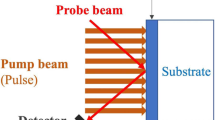The author has proposed a model of brief interaction of liquid and amorphous bodies with boundary conditions of the third kind in the amorphous body without a convective mass flux. Consideration has been given to the thermophysical aspect of formation of the temperature sensation of a biomedical object (BMO) on contact with the liquid body with a different temperature. The procedure of short measurements in the stage of irregular thermal regime (pulse method) was applied to investigation of thermal activity of various anatomical sections of the BMO skin as a function of its temperature. It has been shown experimentally that thermal activity grows with temperature and is within 640–1800 J/(m2·K·s0.5). The total relative error of the method of thermal-activity measurements amounted to ~5%. It has been proposed that analytical calculation of the surface temperature of the BMO on contact be modeled as a combination of the temperatures in liquid and solid media by using the criterion of moisture-content percentage in the BMO.
Similar content being viewed by others
References
A. V. Luikov, Heat Conduction Theory [in Russian], Vysshaya Shkola, Moscow (1967).
G. G. Spirin, D. V. Vasilevskii, and B. A. Preobrazhenskii, Thermophysical aspects of interaction of a pilot with the external medium, Vestn. MAI, 17, No. 4, 23–26 (2010).
G. G. Spirin, Methodological peculiarities of short measurements at the stage of irregular thermal regime, J. Eng. Phys. Thermophys., 38, Issue 3, 227–2329 (1980).
D. S. Simankov and S. Yu. Poberezhskii, Criterion of comfort of temperature sensations of biomedical objects, Modern Problems of Science and Education, No. 2, 2012: http://www.science-education.ru/106-7725.
F. C. Henriquez, Jr., Studies of thermal injury: V. The predictability and the significance of thermally induced rate processes leading to irreversible epidermal injury, Arch. Pathology, No. 43, 489–502 (1947).
G. G. Spirin, Short Measurements in the Stage of Irregular Thermal Regime and Diagnostics of Thermophysical Properties of Dielectric Substances and of Materials Based on Them, Doctoral Dissertation in Technical Sciences, Moscow (1986).
O. A. Timofeev, G. G. Spirin, and D. V. Vasilevskii, Method for investigation of the heat conduction of liquids in microvolumes, Vestn. MAI, 14, No. 1, 50–56 (2007).
G. G. Spirin, N. A. Vanicheva, O. A. Ermakova, and L. V. Yakush, Thermophysical characteristics of biologic tissues, J. Eng. Phys. Thermophys., 50, Issue 1 (1986). Dep. in VINITI RAN 24.06.85. No. 4478-85.
Author information
Authors and Affiliations
Corresponding author
Additional information
Translated from Inzhenerno-Fizicheskii Zhurnal, Vol. 89, No. 1, pp. 177–182, January–February, 2016.
Rights and permissions
About this article
Cite this article
Simankov, D.S. Problem of Brief Interaction of Liquid and Amorphous Bodies. J Eng Phys Thermophy 89, 186–191 (2016). https://doi.org/10.1007/s10891-016-1366-z
Received:
Published:
Issue Date:
DOI: https://doi.org/10.1007/s10891-016-1366-z




